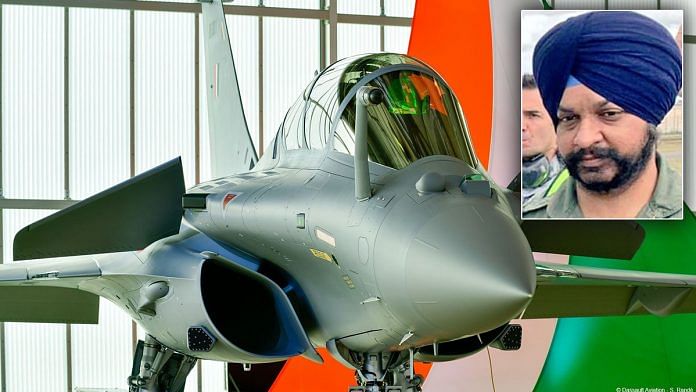New Delhi: With France handing over first of the Rafale fighter jets to India at Merignac Tuesday, photographs of a beaming Defence Minister Rajnath Singh and senior Indian Air Force officers with the aircraft in the background were splashed all over social media.
Standing among the officers was Group Captain Harkirat Singh, the designated Commanding Officer of the newly-resurrected 17th Squadron ‘Golden Arrows’, which will get the first set of four Rafale fighters by the end of May 2020.
Group Captain Singh, earlier a MiG 21 pilot, is known for his “exceptional courage” and was awarded the Shaurya Chakra in 2009 for his brave act that helped save the aircraft as well as his own life.
What happened on the night of 23 September 2008?
Group Captain Singh, then a Squadron Leader, was in a two-aircraft practice interception sortie on the MiG 21 Bison aircraft at night on 23 September 2008.
During the interception phase at an altitude of 4 km, when the pilot engaged reheat to accelerate to the briefed speeds, he noticed a bright flash in the peripheral vision and heard three loud banging noises from the engine, according to his citation.
“He promptly selected reheat off. However, the Rotation Per Minute and Jet Pipe Temperature continued to wind down indicating an engine flame out. This resulted in complete loss of thrust with the speed washing off and the aircraft descending,” reads the Citation of his gallantry award.
Not only this, he also experienced loss of flight and altitude data on the head-up display and multi-functional display.
Adding to the trouble was that the cockpit lights went off with only the battery-operated emergency floodlights being available.
When flying during dark night over the desert, with very few lights on the ground and only stars in the sky, disorientation can occur very quickly.
It is further complicated if a dire emergency, such as a flame-out, occurs.
“In-addition, with only limited head down instruments available against dim cockpit lights, this situation could have also led to disorientation. This coupled with a flamed out engine, presented the pilot with an emergency of the most critical nature on the MiG-21 class of aircraft,” the citation read.
Also read: India gets modern Rafale, but is only major air force to fly these 6 outdated aircraft
Singh’s actions that saved his life and also his aircraft
Singh is said to have calmly assessed the situation and reacted in a controlled manner.
He immediately reduced the angle of attack, thereby preventing the aircraft from entering the stalling regime.
Group Captain Singh took recovery actions of relighting the engine without delay. While doing so, he continued with the difficult task of piloting the aircraft in dark night conditions.
“After a successful relight and with the cockpit lighting restored, he utilised his on board navigation systems along with the assistance from Ground Control Intercept controller to position on final approach followed by a Surveillance Radar Approach to land,” the citation read.
He was now faced with the next demanding task of carrying out an overweight landing in dark night conditions, which calls for high degree of skill levels.
“His exemplary piloting skills with composed mental state under extreme adverse conditions were instrumental in successfully recovering the aircraft. This act of saving the aircraft was undertaken by him in total disregard to his own safety,” the citation read.
It added: “Any wrong input or a delayed action by the pilot would have resulted in a catastrophic accident. After landing, he cleared off the runway and switched off, thereby enabling the recovery of other aircraft.”
The citation said his prompt and correct actions prevented a Category-I accident and saved a valuable aircraft.
Also read: Army plans to buy 350 helicopters over 10 years to modernise its Aviation Corps







Incredible display of indomitable courage
Why so many details and information being given away here and other Indian media outlets about IAF planes, their air maneuvers, capabilities, cockpit details . These media outlets and journalist should be banned and stop boasting. Does an average civilian really care and need to know all of these details? seems so stupid and no wisdom on the part of journalism. I wonder if these supersonic planes can be converted into a hyper sonic flight.
Dont worry mr.musa khan, mr singh is from the same air force & armed. forces which has humiliated your army in all major wars & conflicts,& kept your fascist age old dream of kashmir in dreams only,in addition to dismembering yours in 71,& prove your nations 2 nation theory stupid fascist idea by a rascist monkey.!!!
Is there any pilot in IAF who didn’t face an accident or didn’t have to eject? Such a shameful force it is.
Even prophet Mohammad (s.a.w) during his final journey on a winged horse had faced an accident and had to do an emergency landing.
He was the first airforce pilot from Asia. Its not shameful until you vomit during the ejection.
Salute!
Salute!! These pilots have an enviable day job – handling these beautiful machines and taking split second decisions – especially for those of us who aspired to be, but couldn’t make it for medical reasons.